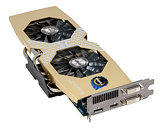Tuesday, April 22nd 2014

No 20 nm GPUs from AMD This Year
It's not just NVIDIA, which will lack 20 nm GPUs in its portfolio this year. AMD senior vice-president Lisa Su, responding to a question by Wells Fargo, in its Q1 investors call, confirmed that her company will stay on 28 nm throughout 2014, and it's only later that it will move on to 20 nm, and FinFET after that. "I think what I said earlier sort of what we're doing in terms of technology strategy, we are 28 this year, we have 20-nanometer in design, and then FinFET thereafter. So that's the overall product portfolio," she said.
AMD and NVIDIA manufacture their GPUs on a common foundry, TSMC, which has faced delays in implementing its 20 nanometer silicon fab node transition, forcing both companies to come up with new GPUs on existing 28 nm nodes. A huge leap in performance could be a tough ask for those new GPUs. NVIDIA is expected to tape out its performance-segment GM204 and mid-range GM206 chips, both of which are 28 nm, later this month, and the first GeForce GTX products based on the two are expected to roll out by late-Q4 2014 and early-Q1 2015, respectively.
Source:
Seeking Alpha
AMD and NVIDIA manufacture their GPUs on a common foundry, TSMC, which has faced delays in implementing its 20 nanometer silicon fab node transition, forcing both companies to come up with new GPUs on existing 28 nm nodes. A huge leap in performance could be a tough ask for those new GPUs. NVIDIA is expected to tape out its performance-segment GM204 and mid-range GM206 chips, both of which are 28 nm, later this month, and the first GeForce GTX products based on the two are expected to roll out by late-Q4 2014 and early-Q1 2015, respectively.

42 Comments on No 20 nm GPUs from AMD This Year
But I echo your sentiment about being excited for seeing designs that aren't tuned to just one TSMC process.
I'm aware they used UMC relatively recently (didn't realise they used IBM a while ago), and they may well do again if they manage to migrate existing designs or make future designs that will work on a low power process. Hence my comment. NVIDIA's 20nm designs are all for TSMC's acutely expensive high power process, so they have no option to move to anyone else for a while, though.
AMD currently PLANS to leave TSMC entirely. That isn't automatic, as you say. But it is what they plan to do.
Which was cancelled two years ago.
FWIW's all the processes being touted as 20nm successor ( TSMC's 16nm, Samsung's 14nm, Intel's 14nm) all use 20nmback end of line(22nm in Intel's case) - it's just the FEOL layer that shrinks. It is why TSMC'sCLN16FF is coming hard on the heels of planar 20nm
So nothing new this year? Hmm, yes please? Is this news now? I kind of understand why it would be.
Common sense doesn't seem a natural partner for the personal computer industry at the best of times. The more scrutiny you give it, the worse it gets.Intel's continued survival in processors seems linked to staying ahead of the competition in process tech. I'm not particularly sold on the idea that Intel can continue to win by going toe-to-toe with their competition on an equal footing (node size and transistor density).
Could leave quite a considerable window where AMD's on a superior process, if they move to GF.
I think we agree that if the CPA 14nm can actually get off the ground in a timely manner, Intel is going to find themselves in some very interesting fight-or-flight situations; some scenarios they haven't seen in a long time, others they have never seen before. It will be interesting to see how they react once the gap is closed and they are faced with competition from not only AMD, but others like Qualcomm whom have been forced to compete with not only less, but much less.
Once upon a time AMD openly fretted, and many journalists opined about them getting through 'the next few years'. On the other side of this transition (which seems much better organized than previous attempts) is the end of that grim period, and we should have a resurgence if well-planned. If not them, then there is ample room for a new power-player in the form of Qualcomm or even nvidia. All things considered, Intel better hold on to their butts.
Said it before, but will say it again. 2014 will likely be boring. The later part of 2015 but more importantly going into the beginning of 2016 is going to be a hugely important time, and a ton of exciting (if not unexpected) things are bound to happen across the tech industry during that year (2016).